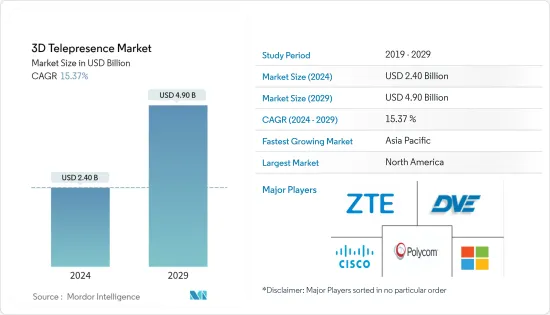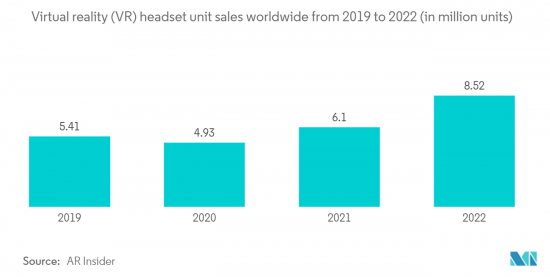 |
市场调查报告书
商品编码
1403973
3D远距临场系统-市场占有率分析、产业趋势与统计、2024-2029 年成长预测3D Telepresence - Market Share Analysis, Industry Trends & Statistics, Growth Forecasts 2024 - 2029 |
||||||
※ 本网页内容可能与最新版本有所差异。详细情况请与我们联繫。
预计 3D远距临场系统市场规模到 2024 年将达到 24 亿美元,预计到 2029 年将达到 49 亿美元,在预测期内(2024-2029 年)复合年增长率为 15.37%。

主要亮点
- AR 和 MR 等先进技术的日益普及预计将为名为 3D远距临场系统的新协作平台铺平道路。 AR 和 MR 等先进技术的日益普及预计将为名为 3D远距临场系统的新协作平台铺平道路。
- 如今,音讯和视讯应用程式(例如 Google Hangouts、Facetime、Skype 和其他办公室视讯会议平台)可供整个企业使用,以实现远端通讯。
- 儘管在过去几年中,音讯和视讯传输的体验品质有了显着提高,但 2D 视讯技术存在一些固有的缺陷,例如眼神接触和手势等非语言线索的损失,这些都是有缺陷的。 3D远距临场系统在两方或多方之间提供 3D 视讯资料的渲染和串流传输,有助于普及3D远距临场系统世界。
- 思科(Spark Systems)等公司正在开发智慧型会议室,捆绑摄影机、4K萤幕扬声器和支援设备,但技术的进步将透过远距临场系统带来更真实的体验。
- 早期进入远距临场系统领域的公司包括思科、微软、Teliris、Huwaei 和SONY。自诞生以来,该技术克服了多项挑战,包括不同供应商的远距临场系统系统之间的互通性以及与不同电信业者提供的网路的兼容性。
- 该技术已在 Musion 3D 等多个娱乐演示中得到应用。然而,迄今为止,此类 3D 系统由于与 2D远距临场系统/视讯会议相比高成本,实用化受到限制。
- 透过利用扩增实境(AR) 与 3D 结合的最新进展,例如 Atheer Air Glasses、Google Glass 和 Microsoft Holens World,可以在现实之上呈现远端位置消费者的数位表示。您可以创建混合实境体验。 COVID-19 爆发后,远距工作和身临其境型体验需求等趋势预计将获得发展动能。从这个角度来看,3D远距临场系统係统对于确保工作流程极为重要。
3D远距临场系统市场趋势
使用者体验的改善预计将推动软体领域的成长。
- 远端沉浸和 3D 技术,无论是与虚拟实境还是扩增实境(AR) 捆绑在一起,都可以增加远端位置使用者的存在感。除了改善目前透过 2D 视讯会议实现的用户通讯体验之外,该技术还可以用于其他几个领域,以减少行动的需要。
- 此外,远端协作等应用程式将受益于这些解决方案,其中来自不同学科的团队必须与 3D资料和模型密切合作,例如设计、製造、医疗保健、物理科学、架构、天文学、数位人文和教育。 .预计将推动需求。
- 此外,旨在加速采用标准视讯会议以实现现实生活体验的倡议正在推动市场成长。例如,去年,Facebook 现实实验室的研究人员宣布开发出虚拟远距临场系统系统,该系统利用逼真的化身来捕捉和传达现实世界中社交互动的凝视和目光接触讯号。
- 根据统计预测,3D远距临场系统系统可以透过更快的决策速度、减少差旅成本和差旅时间,将组织生产力提高高达 40%。

欧洲占据压倒性市场份额
- 为了确保 3D远距临场系统系统的沉浸式体验,我们进行了各种研究。例如,英国莱斯特德蒙福特大学的研究人员正在进行计划,开发新演算法,以减少广泛用于 3D远距临场系统的点云的有损压缩。
- 与传统视讯技术相比,3D 点云具有许多优势,包括自由观点渲染以及自然和合成物件的混合。欧盟资助的OPT-PCC计划将开发新的资料压缩演算法,透过高效的压缩方法来优化影像速率失真性能,增加储存容量并提高频宽利用率,这是有可能的。
- AR 和 MR 等先进技术的日益普及预计将为 3D远距临场系统市场的普及铺平道路。
- 作为产业发展策略的一部分,英国政府去年宣布投资4亿欧元(4.3328亿美元),用于在该国开发前沿研发计划,涵盖AR、VR和MR等身临其境型技术。我们支持你自始至终。这些投资预计将为英国公司增加创建新应用程式、工具和虚拟体验的机会。
- 基于混合实境(MR) 的新兴企业定期吸引投资者进行产品创新资金,以抓住市场成长机会。例如,Zapper 宣布正在为其 MR 设备寻求投资。这家新兴企业最近发布了其应用程式的下一版本。
- 同样,去年,总部位于伦敦的新兴企业Hyper 建构了一个创新的混合实境(MR) 协同设计平台,解决了瓶颈问题。由于 EIT Digital 支援的「HyperCRC」创新活动,Hyper 推出了一个空间设计平台,成功地将 VR 与物理精确的运动轨迹模型融合在一起。
- 此外,Hyper 还提供了一个将 VR 与现实世界运动轨迹模型结合的空间设计平台。该公司提供标准设计包,让客户可以从 40 种材料中进行选择,并在四个身临其境型3D 环境中自订四个物件。此外,该技术允许公司的客户进行远端协作和共同设计。
3D远距临场系统产业概况
由于参与者众多,3D远距临场系统市场高度分散。市场主要参与者有 TelePresence Tech、思科系统公司、微软公司、Teliris, Inc. (Dimension Data)、Digital Video Enterprises Inc.、Musion、Polycom Inc.、中兴通讯公司等。近期市场的主要发展有:
2022 年 11 月,墨西哥新兴企业Inbiodroid 发起了 Kickstarter宣传活动,为其第二版远距临场系统化身机器人提供资金。公司的使命是消除限制人类工业发展的物理障碍,开创一个成长和进步不受空间和时间限制的新时代。
此外,PROMETHEUS 2.0是一款配备远距临场系统技术的尖端分身机器人,它是一个人形机器人身体,可以在世界任何地方即时再现使用者的动作。使用目前正在开发的具有先进功能的全新AVATAR SYSTEM PROTOTYPE,用户将能够透过身临其境型平台和主动通讯介面将他们的意识、技能、动作和意图传输到PROMETHEUS 2.0。
2022 年 2 月,思科为 Webex Hologram 推出了逼真的即时远端远距临场系统功能,这是一项电话会议服务,自 2021 年 10 月以来已逐步向少数客户推出。这项新服务使用相机阵列和 HoloLens 或 Magic Leap AR 头戴式显示器。
其他福利:
- Excel 格式的市场预测 (ME) 表
- 3 个月分析师支持
目录
第一章简介
- 研究假设和市场定义
- 调查范围
第二章调查方法
第三章执行摘要
第四章市场动态
- 市场概况
- 市场促进因素与市场抑制因素介绍
- 市场驱动因素
- 改善使用者体验
- 组织对节省时间的技术的需求不断增长
- 市场抑制因素
- 高成本且商业化有限
- 产业价值链分析
- 产业吸引力-波特五力分析
- 买家/消费者的议价能力
- 供应商的议价能力
- 新进入者的威胁
- 替代品的威胁
- 竞争公司之间敌对关係的强度
- COVID-19 对市场的影响
第五章市场区隔
- 解决方案类型
- 软体
- 硬体
- 目的
- 教育
- 广告
- 会议
- 客户服务
- 其他用途
- 地区
- 北美洲
- 欧洲
- 亚太地区
- 拉丁美洲
- 中东/非洲
第六章竞争形势
- 公司简介
- TelePresence Tech
- Cisco Systems Inc.
- Microsoft Corporation
- Holoxica Limited
- Valorem Reply
- Teliris Inc.(Dimension Data)
- Digital Video Enterprises Inc.
- Musion 3D
- Polycom Inc.
- ZTE Corporation
- MDH Hologram Ltd.
- Primasonic Spectrum Private Ltd.
第七章 投资分析
第八章 市场机会及未来趋势

The 3D Telepresence Market size is estimated at USD 2.40 billion in 2024, and is expected to reach USD 4.90 billion by 2029, growing at a CAGR of 15.37% during the forecast period (2024-2029).
Key Highlights
- The growing adoption of advanced technologies, such as AR and MR, is expected to pave the path for a new collaborative platform called 3D telepresence. The increasing adoption of advanced technologies, such as AR and MR, is expected to pave the way for a new collaborative platform called 3D telepresence.
- Audio and visual applications like Google Hangouts, Facetime, Skype, and other video conferencing platforms for offices exist today for use across enterprises to enable remote communication.
- Although the quality of experience, concerning audio and visual transmission, has significantly improved over the years, 2D video technology has several inherent drawbacks, like loss of non-verbal cues, such as eye contact and gestures, which cannot be mitigated easily. Some of these issues are addressed by 3D telepresence, which provides rendering and streaming of 3D video data between two or more parties, boosting the adoption of 3D telepresence globally.
- While intelligent conference rooms are being developed by companies like Cisco (Spark system), a bundle of cameras, 4K screen speakers, and supporting devices, technology advancements result in more life-like experiences through telepresence.
- Cisco, Microsoft, Teliris, Huwaei, and Sony are among the early entrants in the telepresence space. Since its inception, the technology has overcome a few challenges, such as interoperability between telepresence systems from different vendors and compatibility with networks provided by various telecom companies.
- The technology has been showcased in several entertainment demonstrations, like Musion 3D. However, to date, the practical applications have been limited by the high cost of such 3D systems compared to 2D telepresence/video conferencing.
- The remote consumer's digital representations could be rendered over the real by taking advantage of recent advances in augmented reality (AR), coupled with 3D, such as Atheer air Glasses, Google Glass, and Microsoft hololens world, creating a mixed-reality experience. Following the COVID-19 pandemic, trends such as remote working and the need for immersive experiences were expected to gain momentum. In such a regard, 3D telepresence systems were crucial in ensuring workflow.
3D Telepresence Market Trends
Enhanced User Experience is expected to Drive the Growth in software segment.
- The tele-immersion technology and 3D technology provide an increased presence for remote users, whether bundled with virtual or augmented reality (AR). Aside from enhancing the user experience in terms of communication, which is currently performed with 2D video conferencing, there is a potential use of this technology in several other areas that would reduce the need for travel.
- Moreover, applications, such as in remote collaboration, where multi-disciplinary teams have to work closely with 3D data or models, like in design, manufacturing, medicine, physical sciences, architecture, astronomy, digital humanities, and education, among various other applications, are expected to drive the demand for these solutions.
- Further, initiatives aimed at pushing the deployment of standard video conferencing to achieve real-world experience are driving the market growth. For instance, in the previous year, researchers from Facebook Reality Labs announced the development of a virtual telepresence system that utilizes photorealistic avatars to capture and convey the gaze and eye contact signals of social interactions in the real world.
- Statistical forecasts suggest that an organization could boost its productivity by up to 40% due to quick decision-making, saving travel costs and travel time because of the 3D telepresence systems.

Europe to have a Dominant Share in the Market
- Various research studies are conducted to ensure an immersive experience in 3D telepresence systems. For instance, researchers from the De Montfort University in Leicester, United Kingdom, are working on a project to develop new algorithms that could reduce lossy compression of point clouds whose usage is widely observed in 3D telepresence.
- Compared to traditional video technology, 3D point clouds offer various advantages, such as free-viewpoint rendering and a mix of natural and synthetic objects. The EU-funded OPT-PCC project is developing new data compression algorithms to optimize the image rate-distortion performance with efficient compression methods that could increase storage capability and improve bandwidth usage.
- The growing adoption of advanced technologies, such as AR and MR, is expected to pave the path for increased adoption of the 3D telepresence market.
- As part of its industrial development strategy, the United Kingdom government announced an investment of EURO 400 million (USD 433.28 million) the previous year to back cutting-edge R&D projects across the country, covering immersive technologies like AR, VR, and MR. Such investments are expected to increase opportunities for United Kingdom-based businesses to create new apps, tools, and virtual experiences.
- Mixed reality (MR) based startups regularly attract investors' funds for product innovations to seize market growth opportunities. For instance, Zapper announced raising investments for its MR device. The startup recently released the next version of its app.
- Similarly, the previous year, Hyper, a London-based startup, created an innovative Mixed Reality (MR) co-design platform that addresses the bottleneck. Hyper has introduced a spatial design platform that can successfully merge VR with physically accurate, motion-tracked models, owning to the EIT Digital-supported "HyperCRC" innovation activity.
- Moreover, Hyper provides a spatial design platform that combines VR with real-world motion-tracked models. The company offers a standard design package that allows customers to choose from 40 different materials and customize four objects within four immersive 3D environments. Furthermore, the technology enables the company's clients to collaborate and co-design remotely.
3D Telepresence Industry Overview
The 3D Telepresence Market is Highly fragmented due to the presence of a large number of players. Major players in the market include TelePresence Tech, Cisco Systems Inc., Microsoft Corporation, Teliris, Inc. (Dimension Data), Digital Video Enterprises Inc., Musion, Polycom Inc., and ZTE Corporation. Some key recent developments in the market are as follows:
In November 2022, Inbiodroid, a Mexican startup, launched a Kickstarter campaign to fund the second version of its telepresence avatar robot. The company's mission was to break down the physical barriers that limited humanity's industrial progress and ushered in a new era in which growth and advancement were not limited by space or time.
Moreover, PROMETHEUS 2.0, the most advanced Avatar robot with telepresence technology, is a humanoid robotic body capable of replicating its user's movements in real-time from anywhere in the world. Using a completely new AVATAR SYSTEM PROTOTYPE - with advanced features currently in development - users can transfer their awareness, skills, movements, and intentions to PROMETHEUS 2.0 via an immersive platform and an active communication interface.
In February 2022, Cisco rolled out a photorealistic real-time remote telepresence feature for Webex Hologram, its teleconferencing service that was slowly rolling out with a handful of clients since October 2021. The new service uses a camera array and a HoloLens or Magic Leap AR head-mounted display.
Additional Benefits:
- The market estimate (ME) sheet in Excel format
- 3 months of analyst support
TABLE OF CONTENTS
1 INTRODUCTION
- 1.1 Study Assumptions and Market Definition
- 1.2 Scope of the Study
2 RESEARCH METHODOLOGY
3 EXECUTIVE SUMMARY
4 MARKET DYNAMICS
- 4.1 Market Overview
- 4.2 Introduction to Market Drivers and Restraints
- 4.3 Market Drivers
- 4.3.1 Enhanced User Experience
- 4.3.2 Increasing Demand For Time-Saving Technologies In Organizations
- 4.4 Market Restraints
- 4.4.1 High Costs And Limited Commercialization
- 4.5 Industry Value Chain Analysis
- 4.6 Industry Attractiveness - Porter's Five Forces Analysis
- 4.6.1 Bargaining Power of Buyers/Consumers
- 4.6.2 Bargaining Power of Suppliers
- 4.6.3 Threat of New Entrants
- 4.6.4 Threat of Substitute Products
- 4.6.5 Intensity of Competitive Rivalry
- 4.7 Impact of COVID-19 on the Market
5 MARKET SEGMENTATION
- 5.1 Solution Type
- 5.1.1 Software
- 5.1.2 Hardware
- 5.2 Application
- 5.2.1 Education
- 5.2.2 Advertising
- 5.2.3 Conferencing
- 5.2.4 Customer Service
- 5.2.5 Other Applications
- 5.3 Geography
- 5.3.1 North America
- 5.3.2 Europe
- 5.3.3 Asia-Pacific
- 5.3.4 Latin America
- 5.3.5 Middle East and Africa
6 COMPETITIVE LANDSCAPE
- 6.1 Company Profiles*
- 6.1.1 TelePresence Tech
- 6.1.2 Cisco Systems Inc.
- 6.1.3 Microsoft Corporation
- 6.1.4 Holoxica Limited
- 6.1.5 Valorem Reply
- 6.1.6 Teliris Inc. (Dimension Data)
- 6.1.7 Digital Video Enterprises Inc.
- 6.1.8 Musion 3D
- 6.1.9 Polycom Inc.
- 6.1.10 ZTE Corporation
- 6.1.11 MDH Hologram Ltd.
- 6.1.12 Primasonic Spectrum Private Ltd.













